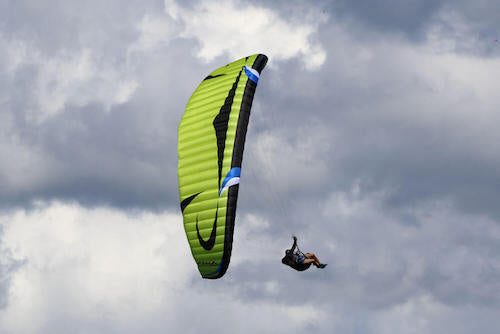The exhilarating world of paragliding offers a unique blend of freedom and adventure, but for many, the prospect of taking flight is accompanied by a wave of anxiety and fear.
The fear of the unknown, the unease of being airborne, and the uncertainties associated with this exhilarating sport can create significant mental barriers.
Whether you're a seasoned paraglider seeking inspiration or someone contemplating their first flight, this blog aims to illuminate the path from fear to confidence, proving that the sky is not just a limit; it's a canvas for personal growth and conquest.
Paragliding is an exhilarating sport that combines the thrill of flying with the beauty of the natural world. However, like any adventure activity, paragliding comes with its share of psychological challenges, particularly related to fear and anxiety, for some individuals.
Understanding Fear and Anxiety
Fear and anxiety are natural human responses designed to protect us from perceived threats. In paragliding, these emotions can manifest due to the inherent risks associated with flying.
Common Triggers
Height: The fear of heights is a common trigger for anxiety in paragliding. The vast open space beneath, combined with the elevation, can trigger a primal fear response.
Control: Feeling a lack of control or having doubts about equipment and conditions can intensify fear.
Weather Conditions: Unpredictable weather patterns and changing wind conditions can contribute to anxiety among paragliders.
The Mind's Response to Perceived Risks
Fight or Flight: The mind often goes into a "fight or flight" mode, releasing adrenaline and heightening senses in response to perceived threats.
Coping Mechanisms
Education: Learning about paragliding equipment, weather patterns, and safety protocols can empower individuals, reducing anxiety related to the fear of the unknown.
Exposure Therapy: Gradual exposure to challenging conditions, under the guidance of experienced instructors, can help desensitize individuals to their fears.
Insights from Experts
Psychological Training: Some paragliding schools incorporate psychological training to help participants build mental resilience and cope with fear.
Professional Guidance: Seeking guidance from experienced paragliding instructors can provide valuable insights and coping strategies.
Group Dynamics: Flying in groups and sharing experiences with fellow paragliders can create a supportive environment, normalizing fears and fostering a sense of community.
Understanding the psychology of fear in paragliding is essential for both enthusiasts and instructors. By addressing common triggers, recognizing the mind's response to perceived risks, and implementing effective coping mechanisms, individuals can enhance their overall experience and safety in this thrilling sport
Sarah's Journey Overcoming Paragliding Anxiety
Meet Sarah Thompson, an avid adventurer who embarked on a personal journey to conquer her paragliding anxiety, transforming it into a triumph of courage and resilience.
Sarah, a 35-year-old marketing executive, was drawn to the allure of paragliding but found herself grappling with intense anxiety at the thought of taking to the skies. Her fear of heights, coupled with a sense of losing control, initially kept her grounded despite her deep desire to experience the thrill of paragliding.
Sarah recognized that overcoming her anxieties required a strategic approach. Instead of avoiding the fear, she decided to confront it head-on. The following are the steps she took to overcome her paragliding anxiety
Education and Understanding
Sarah immersed herself in learning about paragliding. Understanding the mechanics of the equipment, safety protocols, and the physics of flight helped demystify the experience for her.
Gradual Exposure
Rather than diving straight into a solo flight, Sarah opted for a gradual exposure approach. She started by observing paragliding sessions and then progressed to tandem flights with experienced pilots. This allowed her to acclimate to the environment in a controlled manner.
Professional Guidance
Seeking the guidance of a seasoned paragliding instructor was a crucial step for Sarah. The instructor provided personalized coaching, addressing her specific fears and offering strategies to manage anxiety during flights.
Supportive Community
Joining a paragliding community proved instrumental for Sarah. Sharing experiences and fears with fellow enthusiasts created a supportive environment where she felt understood and encouraged.
Soaring Beyond Fear in Paragliding
In exploring the personal story of Sarah who conquered paragliding anxiety and the strategies for overcoming fears, several key takeaways emerge such as the importance of understanding paragliding, progressing gradually, seeking professional guidance, and connecting with a supportive community.
These approaches collectively empower individuals to navigate and conquer their fears in the exhilarating paragliding world.
If you find yourself grappling with paragliding anxiety, know that you are not alone.
Share your experiences with others, whether in your paragliding community or with friends and family. Seek support from experienced instructors or professionals who can offer personalized guidance tailored to your specific fears.
Paragliding is not just a physical endeavor; it is a journey of self-discovery and resilience. Embrace the challenge, learn from others, and remember that conquering fears is a continuous process. By facing your anxieties, seeking knowledge, and building a supportive network, you can transform fear into a source of strength.











